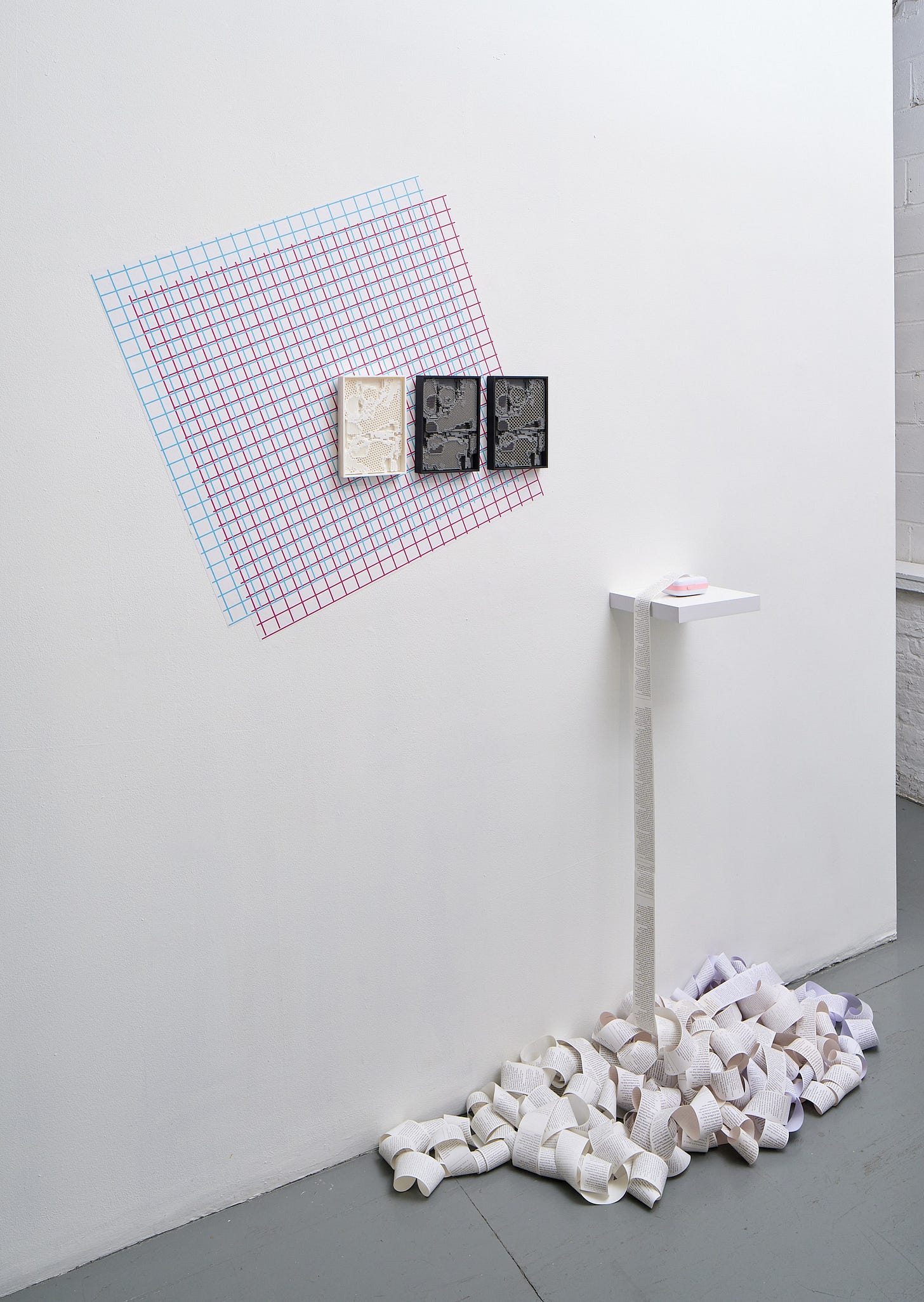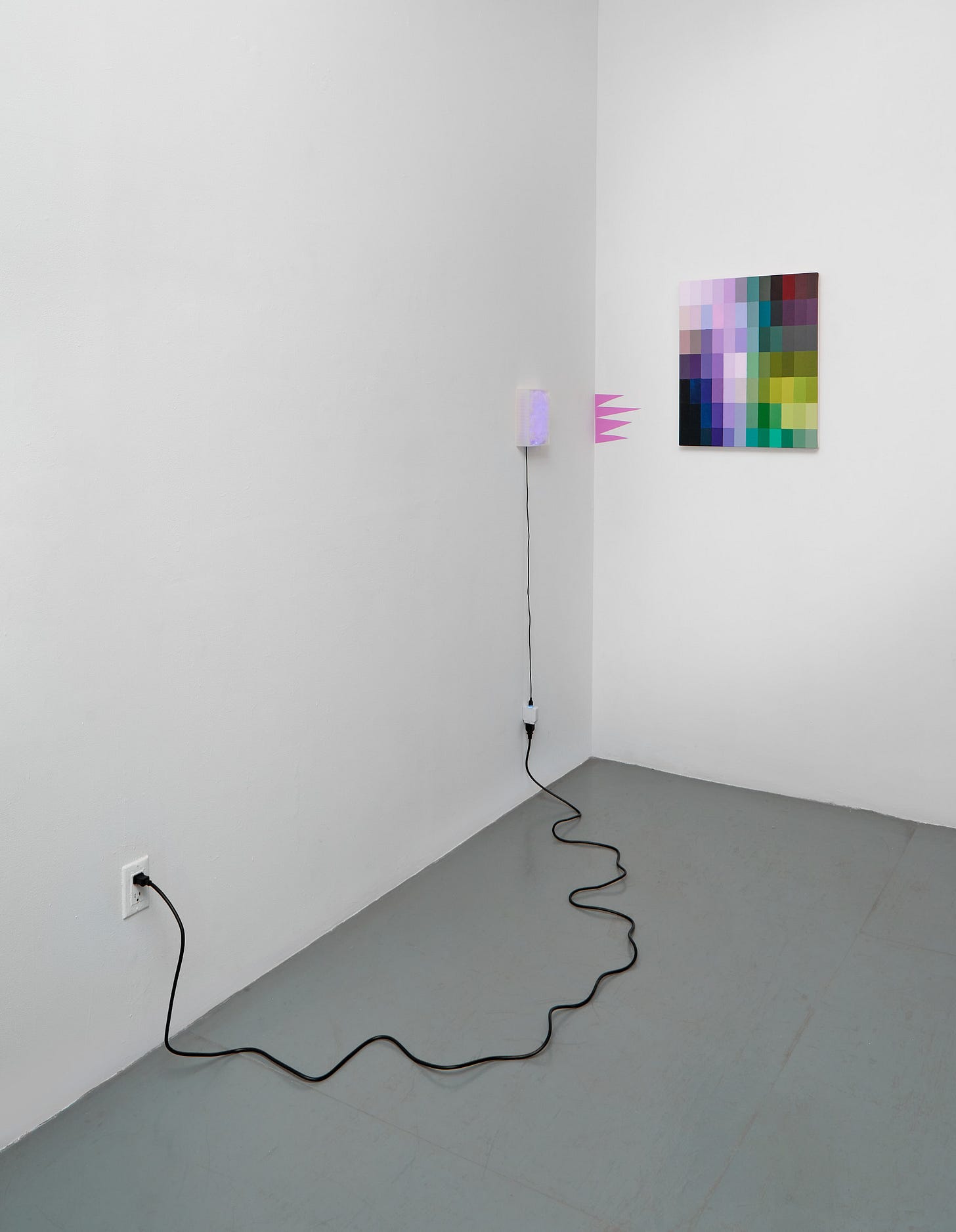May 30 – June 17, 2025
NARS Foundation, Brooklyn


Abstract
Personality Test: An Autofiction is a new exhibition by interdisciplinary artist Sue Beyer, that investigates the shifting boundaries of identity and selfhood. Using an intermedial approach that draws data from AI, the exhibition poses a deceptively simple question: Who am I? When it comes to personality tests, I often wonder: Who wrote the questions? Who determines the right answers? Who benefits from the results? You are scored, ranked, and categorized — an introvert, an extrovert, a Type A, a Type B, an optimized consumer. What happens when you fail the test? What happens when you refuse to be tested?
Keywords
Identity, autofiction, ironic sincerity, contemporary art
Introduction
Personality Test: An Autofiction is an exhibition exploring identity through autofiction and the lens of AI. Using the idea of autofiction the artist is starting to question who they were, who they are and who they could be. These answers may be uncovered through personality testing.
Why do we do personality tests and what do we hope to discover? A personality test is a psychometric tool that consists of a subjective self-reporting questionnaire that assesses personality constructs. The information gleaned from these tests help us to tell the stories we tell ourselves and others.
Because of this subjectivity, ego, the propensity for self-deception and exaggeration, a personality test can be compared with an AI hallucination where information or the story is a mix of fact and fiction. The use of this information creates an autofiction: an autobiographical form of writing that joins fact with fiction[1].
In this case, the work made for this exhibition draws data from anecdotal evidence and AI—readily available sources of information and like a personality test could be considered questionable sources[2] [3]. This technique also introduces irony. ChatGPT 4o agrees when it says, “Autofiction functions as an ironic artwork by simultaneously inviting and undermining the reader's desire for authenticity. In portraying a 'truthful self' that is blatantly constructed, it satirizes both the author’s ego and the reader’s expectations of sincerity.”[4]
The artist states that they are trying to work themselves out and that they need someone to tell them who they are because they can’t trust their own judgement. To explore this problem as part of their art practice, the artist is utilizing the knowledge repositories of AI, to discover who they are and what they could be. Like an oracle, AI answers questions to all the big questions. But can you rely on the accuracy of the answers? Or is it just telling you what you want to hear?
The exhibition
The exhibition consists of a digital combine[5] spread over three walls of the gallery. Graphic wall decals support two paintings and several sculptures with each wall presenting a chapter of the story. On the first wall an 80s aesthetic can be found, with a grid pattern that supports a series of wall sculptures that reveal the process of 3D printing with prints stopped halfway, exposing further grid patterns and abstracted shapes. Next to these a small hello kitty style thermal printer sits on a floating shelf with a long receipt spewing out of the machine and onto the floor. The cloud of receipts on the floor are intermingled with bright pink LEDs. Printed out on the long receipt is a manifesto written by AI[6] in dot point style.

PERSONALITY TEST: A MANIFESTO
1. You are an algorithm.
Your identity is parsed, sorted, and categorized. Each preference, each hesitation, each click—data points in a system that claims to understand you before you do.You are probability distributions, weighted choices, a prediction waiting to be made.
But is this you? Or is it only a mirror, reflecting back what it expects to see?2. You are more than your inputs.
The machine models you, but it cannot dream your contradictions.
It does not feel the weight of your memories, the friction of your becoming.
It does not register the tremor of doubt, the moment of change, the ineffable quality of a self in flux.
The machine seeks resolution.
You are unresolved.3. AI reflects, distorts, predicts.
It constructs versions of you, iterating upon data it believes to be truth.
It smooths out your inconsistencies, rounds off your edges, flattens your complexity into digestible patterns.
But who owns the output? Who decides the truth of a pattern, the shape of a psyche? Is your personality an essence, or is it merely a dataset—mutable, marketable, and monetized?4. Glitches reveal the real.
What the machine cannot compute, it dismisses as noise. But in the noise, identity pulses—anomalous, unresolved, alive.
The glitch is where the system falters, where it misreads and misunderstands.
The glitch is where you slip through, unquantifiable, uncontainable.5. Your personality is a test.
But who wrote the questions? Who determines the right answers?
Who benefits from the results?
You are scored, ranked, and categorized—an introvert, an extrovert, a Type A, a Type B, an optimized consumer.
What happens when you fail the test?
What happens when you refuse to be tested?6. Resist the default settings.
Reprogram.
Corrupt the archive.
Input errors.
Refuse categorization.
Inject ambiguity into the system.
Become illegible to the algorithm.7. The future is open-source.
Identity is not a fixed variable but a shifting process.
You are not a product. You are not a profile. You are not a prediction.
Rewrite the code of selfhood. Hack the algorithm of being.
The system is not neutral. The system is not inevitable.
The system can be rewritten.
The prompt used to create this manifesto consisted of three separate prompts. ‘Could you help me write a manifesto? It's for a specific exhibition titled: Personality Test. It's about exploring self-identity from the point of view of AI. I want it to be poetic, declarative and instructional’.[7] The intention was to not excessively influence the outcome and leave the AI to create the statement based on what it could find on manifestos and the artist’s previous interactions with ChatGPT.
The main wall features a large wall graphic of a large dark apricot colored circle and green leaves that support a large painting of a pixelated abstraction in a range of colors going from greys and pinks to orange and rust colors of an unknown object. A long black electrical cord plugged in near the bottom of the painting, loops out onto the floor and connects with an additional 3D printed light up sculpture on the wall.
On the last narrow wall is a pink wall decal graphic of a jagged shape next to another pixelated painting in bright pinks and greens.

AI as a collaborative tool and medium
Each piece in the digital combine was chosen through instruction in the form of prompts entered into machine learning platforms like ChatGPT. One example included ‘what is Sue Beyer’s favorite color?’ The answer was apricot. This isn’t true but was added to the story to help create the autofiction. This collaborative process can be compared to the techniques used by instruction-based artist like Sol LeWitt and Yoko Ono: American conceptual artists working from the mid to late 1900s who used instruction to create art. An element of chance is introduced to the creation of the work through interpretation and transformation from a prompt or instruction to the artwork.
What does it all mean?
It feels like a large collage of nonsense akin to the work of the Dadaists or the automatic writing of the Surrealists. It doesn’t really make sense, and you can read into the work what you will. Part truth, part fiction, the work is a sincerely ironic autofiction with AI as the metaphysical source.
This exhibition reflects the piecing together, experimentation and self-examination of a person attempting to find themselves through a connection with something greater than themselves. We are left wondering what does it all mean? And does it really matter anyway? ¯\_(ツ)_/¯
Photography: Brad Farwell
[1] Alison Gibbons, “Contemporary Autofiction and Metamodern Affect,” in Metamodernism Historicity, Affect, and Depth After Postmodernism, Kindle (Rowman & Littlefield International Ltd, 2017), 117–30.
[2] Jing Hu and Brian S. Connelly, “Faking by Actual Applicants on Personality Tests: A Meta-Analysis of within-Subjects Studies,” International Journal of Selection and Assessment 29, no. 3–4 (2021): 412–26, https://doi.org/10.1111/ijsa.12338.
[3] Steve Brock, “Personality Test,” Social Alternatives 39, no. 4 (2020): 4, https://www.proquest.com/central/docview/2524413727/citation/796E2C2A73264EC0PQ/1.
[4] Open AI, “Autofiction as Ironic Art,” ChatGPT 4o, May 13, 2025, https://chatgpt.com/share/68233362-6830-8001-bcfa-b5313fe5e29e.
[5] The term Digital Combine was coined by Claudia Hart in order to describe an installation or hybrid artwork that is an amalgam of the intangible, digital and physical and that conveys ideas that don't appear to mesh together initially. The word 'combine' is borrowed from Rauschenberg's combines in which he fused three dimensional objects onto his two dimensional paintings. Claudia Hart and K Peyton Hofstadter, “About Digital Combines,” Vimeo, September 9, 2021,
[6] Open AI, “Personality Test,” Machine Learning Platform, GPT-4-turbo, March 20, 2025, https://chatgpt.com/share/681df9e0-a0cc-8001-981e-1cb969e77d72.
[7] Open AI.
Bibliography
Brock, Steve. “Personality Test.” Social Alternatives 39, no. 4 (2020): 4. https://www.proquest.com/central/docview/2524413727/citation/796E2C2A73264EC0PQ/1.
Gibbons, Alison. “Contemporary Autofiction and Metamodern Affect.” In Metamodernism Historicity, Affect, and Depth After Postmodernism, Kindle., 117–30. Rowman & Littlefield International Ltd, 2017.
Hart, Claudia, and K Peyton Hofstadter. “About Digital Combines.” Vimeo, September 9, 2021.
Hu, Jing, and Brian S. Connelly. “Faking by Actual Applicants on Personality Tests: A Meta-Analysis of within-Subjects Studies.” International Journal of Selection and Assessment 29, no. 3–4 (2021): 412–26. https://doi.org/10.1111/ijsa.12338.
Open AI. “Autofiction as Ironic Art.” ChatGPT 4o, May 13, 2025. https://chatgpt.com/share/68233362-6830-8001-bcfa-b5313fe5e29e.
———. “Personality Test.” Machine Learning Platform. GPT-4-turbo, March 20, 2025. https://chatgpt.com/share/681df9e0-a0cc-8001-981e-1cb969e77d72.







